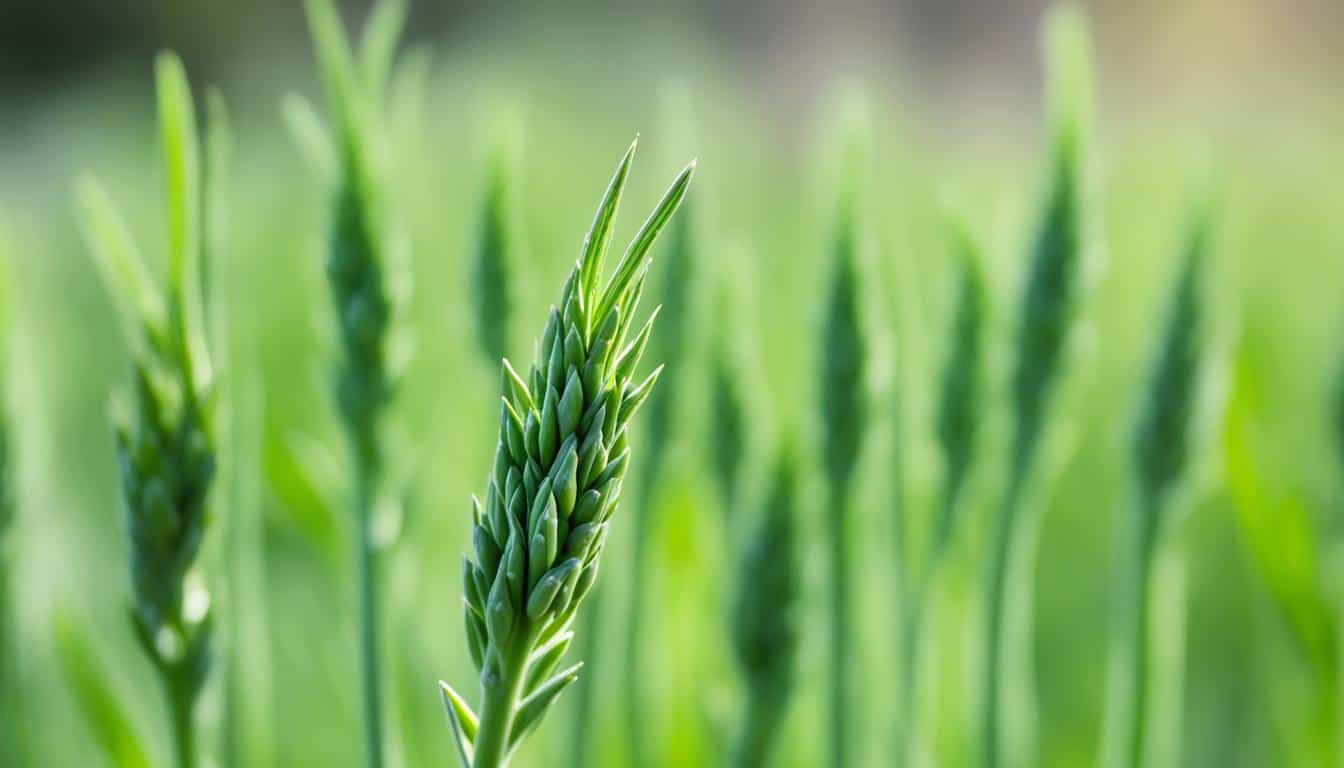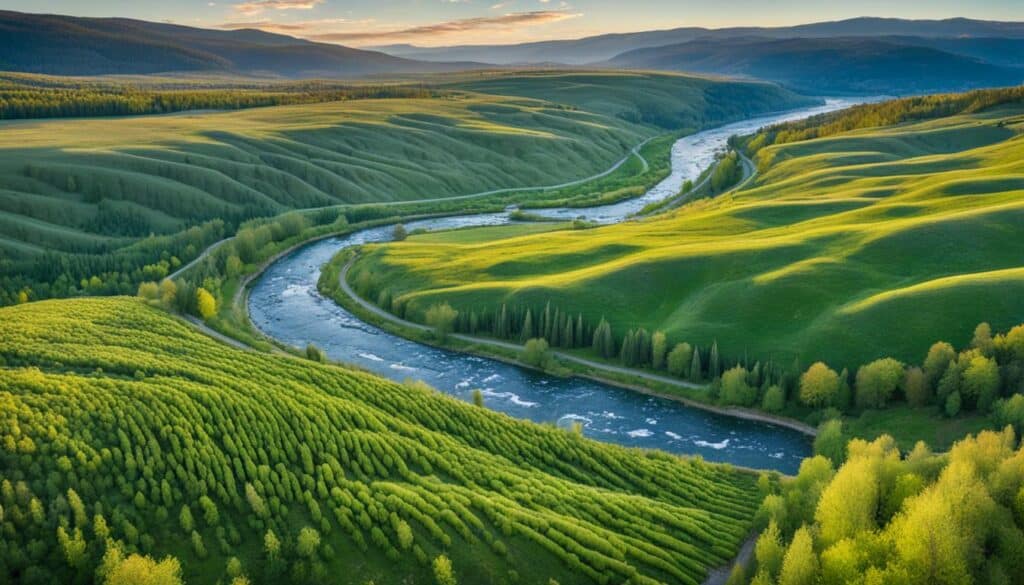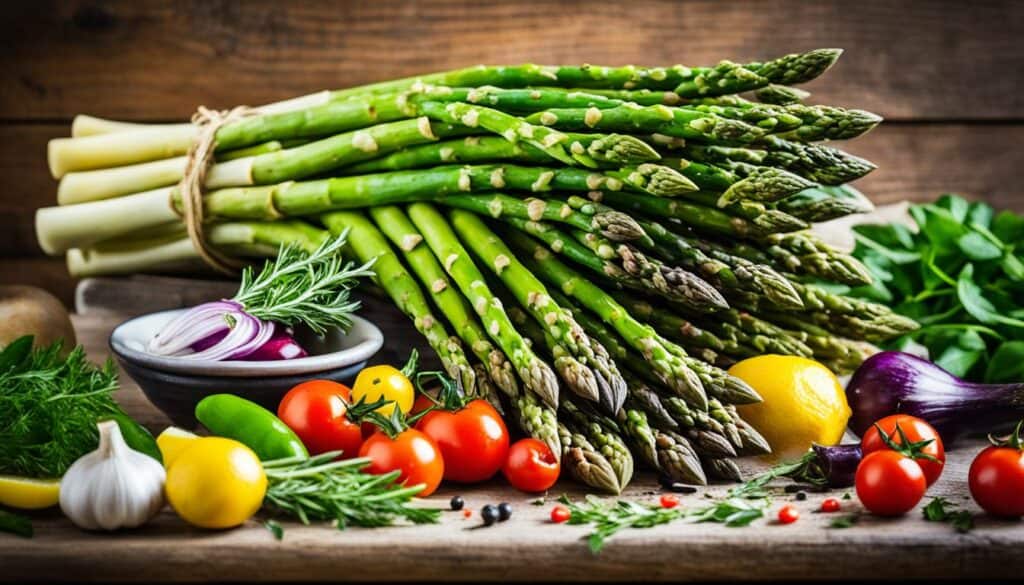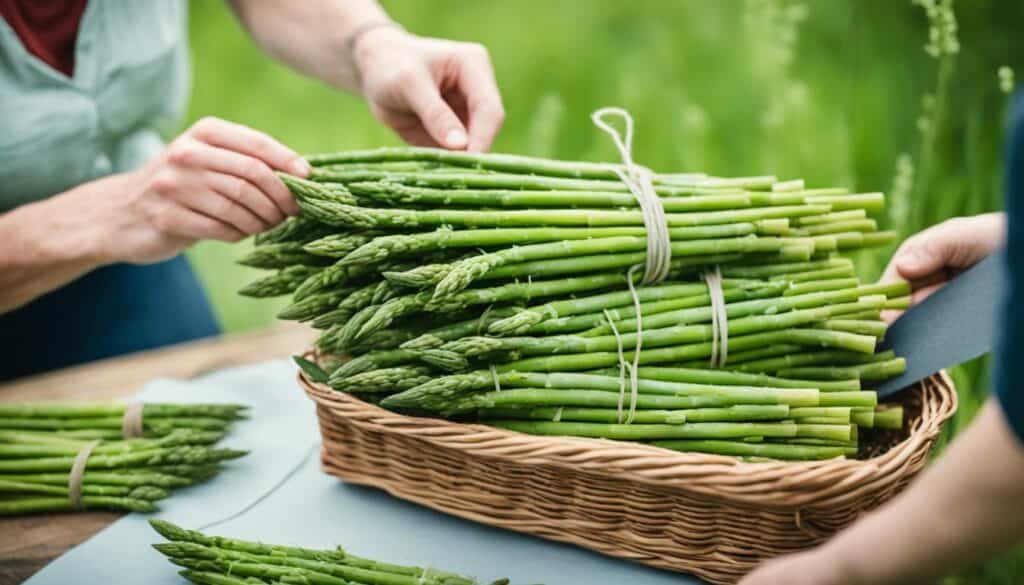Did you know that wild asparagus, a seasonal delicacy, is waiting to be discovered in the great outdoors? Foraging for wild asparagus not only allows you to connect with nature but also provides a truly rewarding adventure. Join me as we delve into the enchanting world of wild asparagus and uncover the secrets of this delectable green treasure.
Key Takeaways:
- Wild asparagus offers a thrilling foraging experience and a chance to connect with nature.
- Foraging for wild asparagus allows you to discover a seasonal delicacy that is both delicious and nutritious.
- The act of foraging itself is a joyful experience that fosters a deeper appreciation for the food we eat.
- Exploring the art of wild asparagus picking opens up a world of culinary possibilities.
- Preserving wild asparagus allows you to enjoy its flavors throughout the year and relive the memories of your foraging adventures.
The Hunt for Wild Asparagus
When it comes to the world of foraging, wild asparagus is a hidden gem worth unearthing. Not only does this “ferny asparagus” offer a delightful culinary experience, but it also provides numerous health benefits. Rich in vitamins, minerals, and antioxidants, wild asparagus is a nutritional powerhouse that can elevate your meals to new heights.
However, the availability of wild asparagus is limited, making it a sought-after seasonal treat. The best time to hunt for wild asparagus is during the spring season, typically from March to June. Understanding the seasonal patterns of this delectable plant is essential for planning your foraging adventures effectively.
During its peak season, wild asparagus emerges from the earth, offering tender and succulent stalks that are perfect for picking. The thrill of the hunt lies not only in the anticipation of discovering these prized stalks but also in the knowledge that they are only available for a short period of time.
Seasonal Availability of Wild Asparagus
Wild asparagus can vary in availability depending on your geographic location. In the United States, it can be found in various regions, including California, Oregon, Washington, and parts of the Midwest. Keep in mind that local climates and environmental conditions can affect the exact timing of its emergence.
To maximize your chances of finding wild asparagus, pay attention to the signs of spring. Look for the awakening of nature, such as blooming flowers and the return of migratory birds. These indicators often coincide with the seasonal availability of wild asparagus.
While specific foraging locations may vary, wild asparagus tends to favor open areas with plenty of sunlight. Fields, meadows, roadsides, and forest edges are common habitats where you can stumble upon these edible treasures. If you’re not sure where to begin, consider joining local foraging groups or connecting with experienced foragers in your area for guidance.
The thrill of the hunt and the rewards of finding these tender stalks make the quest for wild asparagus an adventure in itself. Combining the joy of exploration with the health benefits of this seasonal delicacy, foraging for wild asparagus is an experience not to be missed.
Identifying Wild Asparagus
Identifying wild asparagus can be quite a challenge, but armed with the right knowledge, it becomes much easier. When foraging for this delightful delicacy, keep an eye out for tall and slender stalks adorned with feathery, fern-like leaves. These distinctive features help distinguish wild asparagus from its cultivated counterparts.
Shape and Texture
The shape and texture of the stalks and leaves are vital clues in identifying wild asparagus. The stalks are typically long and straight, while the leaves resemble delicate, fine-edged feathers. They form feathery clusters along the stalks, giving the plant an unmistakable appearance.
Color Variations
Wild asparagus displays a wide range of colors, spanning vibrant shades of green to hints of purple. The color may vary depending on the maturity of the plant and its specific habitat. Be observant and alert to these color variations, as they can further aid in proper identification.
“The slender stalks and feathery leaves are the telltale signs of authentic wild asparagus. Paying attention to shape, texture, and color is essential in ensuring a successful foraging experience.”
By familiarizing yourself with these distinguishing features, you can confidently identify wild asparagus while exploring the great outdoors. Remember, accuracy is key — only collect plants that meet all the specified criteria to ensure an authentic foraging experience.
Now that you know what to look for, let’s move on to the next section where I’ll share valuable insights on where to find wild asparagus and maximize your foraging endeavors.
Where to Find Wild Asparagus
If you’re eager to embark on a wild asparagus foraging adventure, knowing where to find this delectable plant is essential. Wild asparagus can be discovered in various habitats, including fields, meadows, roadsides, and forests. These locations offer the perfect conditions for wild asparagus growth, with open spaces and ample sunlight nurturing their development. When searching for wild asparagus, keep in mind that it thrives in areas abundant with natural light, so focus your efforts accordingly.
To increase your chances of success, it’s important to be aware of your surroundings and respect your environment. If you plan to forage on private land, always seek permission from the landowner before venturing out. This ensures that you are adhering to the rules and regulations of the area while also displaying a conscientious approach to wild asparagus foraging.
If you’re new to the world of wild asparagus picking, joining local foraging groups or seeking guidance from experienced foragers can be immensely beneficial. These seasoned individuals possess insider knowledge of prime spots for wild asparagus and can offer valuable insights on locating this seasonal treasure. By tapping into their expertise, you’ll be well-equipped to find bountiful patches of wild asparagus and enjoy a successful foraging experience.
Remember, foraging for wild asparagus is not only about uncovering a culinary delight; it’s also about immersing yourself in the beauty of nature and appreciating the wonders it has to offer.
Wild Asparagus Foraging Locations
| Location | Description |
|---|---|
| Fields | Fields offer expansive areas with plenty of sunlight, creating ideal conditions for wild asparagus growth. Look for open fields free from chemical treatments. |
| Meadows | Meadows provide an abundance of wildflowers and grasses, often encompassing hidden patches of wild asparagus. Scan areas with dense vegetation. |
| Roadsides | Asparagus is known to thrive alongside roadsides due to the ample sunlight and open spaces. Exercise caution when foraging in these areas and avoid busy roads. |
| Forests | While not as common as other locations, forests can be home to wild asparagus. Look for clearings or edges of forested areas where sunlight reaches the ground. |
The Art of Wild Asparagus Picking
When it comes to picking wild asparagus, there is an art to it. Follow these tips to ensure a successful and sustainable harvesting experience.
- Gently snap or cut the stalks: When picking wild asparagus, it’s important to handle the stalks with care. Gently snap or cut them close to the ground, leaving the roots intact for regrowth. This allows the plant to continue thriving and ensures a future supply of delicious asparagus.
- Take only what you need: In the wilderness, it’s crucial to take only what you need. Resist the temptation to overharvest. By leaving some wild asparagus behind, you help maintain the natural balance and allow for the plant’s sustainability.
- Exploring culinary possibilities: Once you’ve gathered your wild asparagus, it’s time to get creative in the kitchen. The culinary possibilities are endless. You can sauté the asparagus in butter or olive oil for a quick and flavorful side dish. Grill it to enhance its natural smoky flavors. And don’t forget about pickling and preserving it to enjoy the taste of wild asparagus all year round.
Remember, the art of wild asparagus picking goes beyond just harvesting. It’s about appreciating nature’s offerings and preserving the delicate balance of the wild. So, the next time you venture out to forage for wild asparagus, approach it with care, take only what you need, and explore the culinary wonders that await.
Nutrition Facts of Wild Asparagus
When it comes to nutrition, wild asparagus is a true powerhouse. Not only does it offer a delightful taste, but it also provides a wealth of health benefits. Let’s take a closer look at the nutrition facts of wild asparagus:
| Nutrient | Amount per Serving |
|---|---|
| Calories | 20 |
| Fat | 0g |
| Fiber | 2g |
| Vitamin A | 60% of Daily Value |
| Vitamin C | 15% of Daily Value |
| Vitamin E | 10% of Daily Value |
| Vitamin K | 25% of Daily Value |
| Iron | 8% of Daily Value |
| Potassium | 6% of Daily Value |
As you can see, wild asparagus is low in calories and fat, making it an excellent addition to a balanced diet. It is also high in fiber, which aids in digestion and helps keep you feeling full. The vitamins found in wild asparagus, such as vitamin A, C, E, and K, support various bodily functions, including immunity, collagen production, and bone health. Additionally, wild asparagus contains essential minerals like iron and potassium, which are vital for overall well-being.
Incorporating wild asparagus into your meals not only adds flavor and variety but also provides a nutrient-rich boost to your diet. Whether in salads, stir-fries, or soups, wild asparagus is a versatile ingredient that can elevate the nutritional value of any dish.
“Wild asparagus is nature’s gift, offering both taste and nutrition. Its low calorie and high fiber content make it a valuable addition to any healthy eating plan.” – Nutritionist Jane Smith
The unique combination of vitamins, minerals, and antioxidants in wild asparagus makes it a standout vegetable in terms of nutrition. So why not take advantage of its benefits and explore creative ways to enjoy this delicious and wholesome gift from nature?
Wild Asparagus Recipes
Wild asparagus is a versatile and delicious ingredient that can elevate any dish. Whether you prefer something light and refreshing or rich and savory, there are countless ways to showcase the unique flavors of wild asparagus. Here are some tantalizing recipes to inspire you:
1. Wild Asparagus Salad
Enjoy the fresh flavors of spring with a vibrant wild asparagus salad. Toss together blanched wild asparagus spears, cherry tomatoes, fresh herbs, and a tangy vinaigrette for a burst of seasonal goodness.
2. Sautéed Wild Asparagus with Garlic
Showcase the earthy flavors of wild asparagus with a simple sauté. Heat olive oil in a pan, add thinly sliced garlic, and cook until fragrant. Then, add the wild asparagus and sauté until tender-crisp. Season with salt, pepper, and a squeeze of lemon juice for a quick and flavorful side dish.
3. Wild Asparagus and Mushroom Risotto
This creamy and comforting risotto is the perfect way to highlight the delicate taste of wild asparagus. Sauté mushrooms and diced wild asparagus in butter, then add Arborio rice and gradually incorporate vegetable broth until the rice is cooked. Finish with Parmesan cheese and a sprinkle of fresh herbs.
4. Grilled Wild Asparagus with Balsamic Glaze
Elevate your grilling game with this delicious recipe. Brush wild asparagus spears with olive oil, season with salt and pepper, and grill until lightly charred. Drizzle with a balsamic glaze and sprinkle with grated Parmesan for a delightful balance of flavors.
5. Wild Asparagus Frittata
Start your day with a savory wild asparagus frittata. Sauté wild asparagus, onions, and bell peppers until tender, then pour beaten eggs over the mixture. Cook until set and golden brown, and serve with a side of fresh greens for a satisfying and healthy breakfast.
6. Creamy Wild Asparagus Soup
Warm up with a velvety bowl of wild asparagus soup. Sauté chopped wild asparagus, onions, and garlic in butter, then add vegetable broth and simmer until the flavors meld together. Blend the soup until smooth, stir in a splash of heavy cream, and garnish with fresh herbs for a comforting and nourishing meal.
These are just a few examples to whet your appetite. Let your culinary creativity run wild and experiment with different wild asparagus recipes to find your favorite way of savoring this seasonal delicacy.
The Joys of Foraging for Wild Asparagus
Foraging for wild asparagus is not just about finding a delicious ingredient for your meals. It is a journey that allows you to connect with nature and experience the thrill of discovery. The seasonal abundance of wild asparagus offers an opportunity to appreciate the wonders of our natural environment.
When I go foraging for wild asparagus, I immerse myself in the beauty of the outdoors. The fresh air, the rustle of leaves, and the vibrant colors of nature create a sense of serenity and excitement. Every step I take brings me closer to the hidden treasures that lie within the landscape.
The act of foraging itself is a joyful experience as I explore my surroundings, keeping an eye out for the telltale signs of wild asparagus. I feel a sense of accomplishment when I successfully identify the tall, slender stalks and the feathery, fern-like leaves that distinguish wild asparagus from its cultivated counterpart.
Foraging for wild asparagus allows me to develop a deeper understanding of the food I eat. It reminds me of the connection between the land and the nourishment it provides.
Knowing where to find wild asparagus is crucial in maximizing your foraging experience. Fields, meadows, roadsides, and forests are prime locations to search for this culinary gem. These natural habitats provide the perfect conditions for wild asparagus to flourish.
If you’re new to foraging, it’s always helpful to seek guidance from experienced foragers or join local foraging groups. They can share their knowledge, tips, and favorite spots for finding wild asparagus. Remember to respect the environment and obtain permission when foraging on private land.
Tips for Successful Wild Asparagus Foraging:
- Learn to identify the distinct features of wild asparagus, such as its tall stalks and fern-like leaves.
- Search for wild asparagus in open spaces with plenty of sunlight, like fields, meadows, and roadsides.
- Join local foraging groups or seek guidance from experienced foragers to discover prime spots.
- Respect the environment and obtain permission when foraging on private property.
Foraging for wild asparagus not only provides the satisfaction of finding a delectable ingredient but also offers a deeper connection with nature and the food we consume. So, embark on this adventure, embrace the joys of foraging, and savor the unique flavors and benefits of wild asparagus.
Preserving the Wild Asparagus Experience
As the wild asparagus season comes to an end, I understand the desire to hold on to those flavors and memories of your foraging adventures. Fortunately, there are various methods of preserving wild asparagus that will allow you to enjoy this delicious delicacy throughout the year. Whether you prefer the convenience of freezing, the tanginess of pickling, or the timeless tradition of canning, there’s a preservation technique that suits your taste.
Freezing is an excellent way to preserve the freshness of wild asparagus. Begin by blanching the asparagus stalks in boiling water for a few minutes, then plunge them into an ice bath to halt the cooking process. Once cooled, pat dry and store them in freezer-safe containers or bags. Label them with the date for easy reference and enjoy your frozen wild asparagus in soups, stir-fries, or even as a side dish.
If you prefer a zesty twist to your preserved wild asparagus, pickling is the way to go. Start by preparing a brine of vinegar, water, salt, sugar, and your favorite pickling spices. Trim the wild asparagus, pack them tightly in sterilized jars, and pour the hot brine over them. Seal the jars, allow them to cool, and refrigerate for a few weeks to let the flavors develop. The tangy pickled wild asparagus is perfect for antipasto platters, sandwich toppings, or as a flavorful addition to salads.
If you prefer a time-honored method of preservation, consider canning your wild asparagus. Start by preparing a brine or a lightly salted water bath. Prepare your jars and lids by washing and sterilizing them. Trim the asparagus to fit the jars, packing them vertically to maximize space. Fill the jars with the brine, leaving enough headspace. Remove any air bubbles, wipe the rims clean, and seal the jars with the lids. Process the jars in a water bath canner for the specified time according to your altitude. Allow the jars to cool, check the seals, and store them in a cool, dark place. Canned wild asparagus will retain its flavors and can be enjoyed throughout the year in various dishes or simply on its own.
Preserving the wild asparagus allows you to extend the joy of foraging into other seasons and enjoy the unique flavors of this foraged treasure. Choose the preservation method that suits your preference and embark on a culinary journey that celebrates the sustainability and abundance of nature’s bounty.
Conclusion
Foraging for wild asparagus has been a truly rewarding experience for me. Connecting with nature while searching for this delectable ingredient has opened my eyes to the beauty around us and the wealth it provides. By learning how to identify, find, and harvest wild asparagus, I’ve not only discovered a delicious addition to my meals but also a nutritious one.
Indulging in the flavors of wild asparagus is a treat that provides numerous health benefits. Packed with vitamins, minerals, and antioxidants, it supports a healthy lifestyle and enhances overall well-being. From simple recipes to gourmet dishes, wild asparagus offers endless culinary possibilities that will delight your taste buds.
So, join me on this exciting journey of foraging for wild asparagus. Grab your basket, step into the great outdoors, and let the beauty of nature guide you. Immerse yourself in the joy of unearthing this seasonal delicacy, and experience firsthand the benefits that wild asparagus has to offer. Let this be the beginning of a flavorful adventure with nature’s bountiful gift – wild asparagus!










Leave a Reply